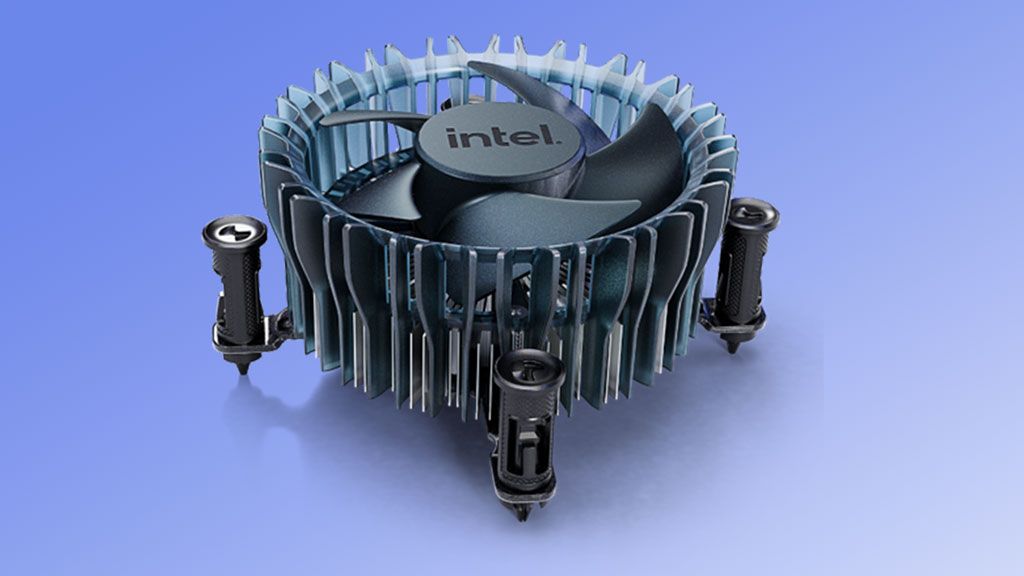Intel discontinues its weakest stock cooler – RS1 Laminar cooler was only used for the Pentium G7400 and Celeron G6900
It will not be missed.

Intel has discontinued its RS1 Laminar stock cooler, which was previously the lowest-end model among the company’s three stock coolers.
Introduced in 2021 alongside 12th Gen Alder Lake CPUs, the RS1 uses an all-aluminum design with a plastic shroud that’s just 47mm tall and weighs around 260 grams. It’s essentially an upgraded version of Intel’s old stock cooler, with a more optimally designed heatsink and a larger, five-blade fan, and is rated to cool 65 watt chips.
Intel also has two other stock coolers, the RH1 and the RM1. The RM1 is almost identical to the RS1, except it has a copper slug at the bottom for better heat transfer, as well as an LED light strip that circles the fan. Like the now-discontinued RS1, the RM1 is also rated for 65 watts. The RH1 meanwhile is a wholly different design that’s taller, uses more copper, and a more premium metal shroud.
The RS1 only ever shipped with two dual-core CPUs: the Pentium Gold G7400 and the Celeron G6900. Although Intel’s weakest stock cooler isn’t particularly robust, it doesn’t struggle to cool either the G7400 or the G6900 since both have a TDP of just 46 watts.
That’s probably one of the main reasons why it got discontinued. It’s hard to justify making a stock cooler just for two CPUs, let alone just for dual-core Pentiums and Celerons, which aren’t exactly popular in recent times.
Intel says that the RS1 won’t have a direct successor, but will just be replaced by the RM1. Simplifying its stock cooler offerings could have also been another motivation for Intel to ditch its all-aluminum cooler since the RS1 and RM1 are already nearly identical. The RM1 is already used for the vast majority of locked Intel CPUs, everything from the Core i3s and the Core i7s in the 12th, 13th, and 14th generations.
The RM1 is also used for the Intel Processor 300, a rebranded Pentium G7400. The Processor 300 came out just around a year ago, and the fact that it used the RM1 may have been a sign that the RS1 wasn’t long for this world.
Stay On the Cutting Edge: Get the Tom's Hardware Newsletter
Get Tom's Hardware's best news and in-depth reviews, straight to your inbox.
Matthew Connatser is a freelancing writer for Tom's Hardware US. He writes articles about CPUs, GPUs, SSDs, and computers in general.
-
jlake3 Huh. Did they maybe expect to launch more low-end models? I think the last-gen cooler they gave some of the i3s the all-aluminum version in some generations, maybe that was the plan at some point?Reply
If the RM1 and RS1 used the same aluminium extrusion and the same plastic moulding then the design cost and tooling cost to make two versions probably wasn’t much higher than just making one version, and omitting the light ring and the machining/assembly related to the copper slug would save money that could add up… but it’s still strange they went through all that for only two chips that aren’t big sellers on the boxed/DIY market. Almost feels like teams weren’t talking to each other over there. -
thestryker Reply
The RS1 was also sold separately to the CPUs, but the RM1 was not. It's possible they had been selling those coolers to some system builders as well.jlake3 said:Huh. Did they maybe expect to launch more low-end models? I think the last-gen cooler they gave some of the i3s the all-aluminum version in some generations, maybe that was the plan at some point?
If the RM1 and RS1 used the same aluminium extrusion and the same plastic moulding then the design cost and tooling cost to make two versions probably wasn’t much higher than just making one version, and omitting the light ring and the machining/assembly related to the copper slug would save money that could add up… but it’s still strange they went through all that for only two chips that aren’t big sellers on the boxed/DIY market. Almost feels like teams weren’t talking to each other over there.
Most Popular

